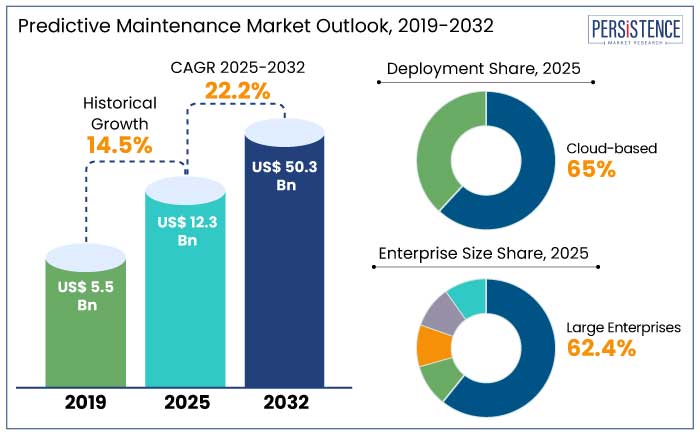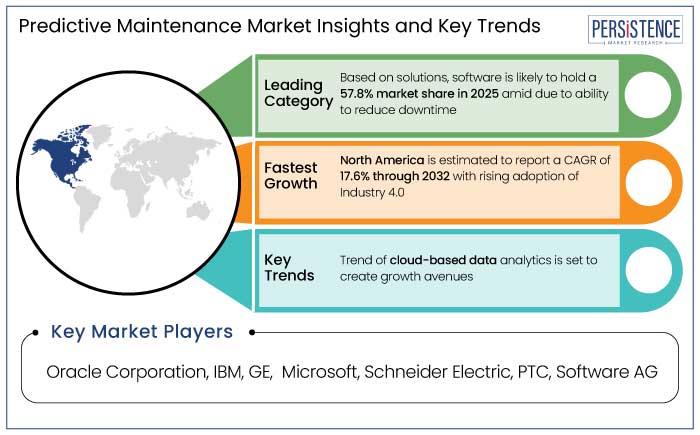ID: PMRREP33672| 192 Pages | 29 Jan 2025 | Format: PDF, Excel, PPT* | IT and Telecommunication

The global predictive maintenance market is estimated to reach a size of US$ 12.3 Bn in 2025. It is predicted to rise at a CAGR of 22.2% through the assessment period to attain a value of US$ 50.3 Bn by 2032.
The technique that combines artificial intelligence (AI), machine learning, and the Internet of Things (IoT), predictive maintenance is transforming industrial operations by evaluating real-time equipment data to spot failure trends and enhance asset utilization.
As digital twin technology becomes more widely used in the industrial and energy industries, it is transforming predictive maintenance by generating real-time virtual copies of physical assets, facilitating remote troubleshooting, and effective system management.

Key Highlights of the Market
|
Market Attributes |
Key Insights |
|
Predictive Maintenance Market Size (2025E) |
US$ 12.3 Bn |
|
Projected Market Value (2032F) |
US$ 50.3 Bn |
|
Global Market Growth Rate (CAGR 2025 to 2032) |
22.2% |
|
Historical Market Growth Rate (CAGR 2019 to 2023) |
14.5% |
North America is set to dominate the predictive maintenance market in 2025, accounting for 35.2% of the global share. Growth is attributed to the unique tech infrastructure, adoption of Industry 4.0 practices, and strong emphasis on operational efficiency in key sectors. The region is estimated to report a CAGR of 17.6% in the projected period.
The U.S., in particular, leads the adoption of IoT, AI, and machine learning in predictive maintenance to reduce downtime and improve asset reliability. For example,
Asia Pacific is projected to dominate the global market by holding 28.7% share in 2025, with a projected CAGR of 18.2% from 2025 to 2032. The region’s manufacturing, energy, and transportation sectors are embracing predictive maintenance to boost efficiency and reduce costs, with industrial IoT adoption increasing by 17% in 2023, according to the studies. For instance,
Large enterprises are predicted to dominate the global market in 2025, accounting for 62.4% of share. It is due to their extensive asset portfolios, complex operations, and novel maintenance strategies.
In 2023, the global adoption of analytics solutions in large enterprises increased by 14%, with manufacturing, energy, and logistics industries leading the charge in terms of reducing downtime and optimizing asset utilization. For example,
Growing adoption of sophisticated analytics and machine learning solutions is set to propel the software segment to 57.8% of the predictive maintenance market share in 2025. Use of predictive maintenance software increased by 15% in 2023. This software reduces maintenance costs and downtime by focusing on real-time data analysis, failure prediction, and asset performance improvement. For example,
The software category is increasing market share due to its economical, scalable solutions, unprecedented flexibility, and predictive maintenance precision.
The rise of predictive maintenance technologies is owing to the increasing digitization of industries, the reduction of equipment downtime and operational costs, the integration of AI and machine learning, and cost savings.
Real-time equipment monitoring and large expenditures in predictive maintenance have resulted from the market's adoption of cutting-edge IoT and sensor technology; wind and solar farms have reported a 40% decrease in unplanned equipment failures.
High implementation costs and technical complexity are among the market's obstacles; 35% of businesses find it difficult to incorporate predictive maintenance solutions into their current infrastructure.
Advanced predictive technologies in the aviation industry have reduced unexpected maintenance issues by 85%, with major investments in AI algorithms, sensor technologies, and machine learning models.

The global predictive maintenance market recorded a CAGR of 14.5% in the historical period from 2019 to 2023. Post-pandemic, cloud computing, IoT sensors, and AI algorithms improved maintenance solutions and helping businesses move from reactive planned maintenance to proactive, predictive approaches. For example,
Demand for predictive maintenance is estimated to record a considerable CAGR of 22.2% during the forecast period between 2025 and 2032.
Integration of IoT and Sensor Technology Enables Sophisticated Monitoring
The demand for predictive maintenance is expanding because of developments in IoT and sensor technologies, which give real-time information on operating factors like vibration, temperature, and pressure across a range of sectors.
In order to maximize performance and minimize operating costs, predictive maintenance solutions drive industrial growth by reducing downtime, optimizing maintenance schedules, extending asset life, and anticipating possible problems.
For industries looking to improve resource reliability and functionality, anticipating equipment problems enables businesses to precisely schedule repair activities, reducing idleness and optimizing resource allocation.
Automation in Manufacturing and Industrial Processing
Increasing automation of manufacturing and industrial processes is driving demand for predictive maintenance solutions to ensure seamless operations and minimize downtime. Rapid evolution of the business and the significance of predictive maintenance for machinery performance are demonstrated by the 12% growth in global automation investment in 2023.
Predictive maintenance solutions, utilizing real-time data and AI, are crucial for industries adopting automation for productivity and cost savings.
Lack of Skilled Workforce Impedes Data Integration
Despite its potential, the predictive maintenance market confronts hurdles such as a shortage of experienced workers and data integration issues. Organizations must combine data from several sensors, devices, and business systems to do this challenging endeavor. Furthermore, there is a lack of qualified experts in analytics, machine learning, and data science in the industry.
Insufficient internal expertise frequently hinders organizations' ability to develop and sustain robust predictive maintenance market strategies. Addressing such challenges is critical for effectively implementing predictive maintenance systems across several sectors.
Integration of AI and ML in Analytics Platforms Displays Productive Results
Preventive maintenance incorporates AI and machine learning to reduce unscheduled downtime and asset breakdowns. To identify component replacements, these systems gather data from manufacturing and environmental processes using IoT hardware components and sophisticated analytics platforms.
Leading industrial AI companies, such as Microsoft and IBM, have launched advanced predictive maintenance platforms integrating machine learning algorithms.
The accuracy and precision of predictive maintenance systems in identifying different problems will be improved by the integration of AI, machine learning, and big data analytics. Meanwhile, IoT and edge computing will boost real-time data gathering and processing, allowing for more flexible maintenance methods.
Growth Cloud-based Data Analytics Offers Lucrative Solutions
Expansion of cloud computing is revolutionizing predictive maintenance by enabling more sophisticated data analysis and predictive modeling. Cloud-based solutions offer scalability, reduced infrastructure costs, and seamless integration with IoT devices, making them accessible to smaller organizations. In 2025, the cloud-based deployment of analytics platforms is estimated to account for 65% of the market share, according to studies.
Microsoft Azure unveiled its Predictive Maintenance AI Suite, leveraging real-time analytics and digital twin technology to monitor asset health.
Cloud computing's position in predictive maintenance is cemented with AWS's IoT TwinMaker update. This, in turn, improves machine uptime, lowers operating costs, and guarantees dependability across various industries.
Key players in the predictive maintenance market are actively pursuing strategies such as mergers and acquisitions, forming strategic partnerships, and launching new products to enhance their presence in the industry.
In recent years, there has been a notable increase in collaborative research and development efforts between major tech companies and specialized manufacturers. Growing synergy has not only bolstered the market position of these leading players but has fostered innovation and advancement in AI and other technology, benefiting the landscape of the global industry.
Recent Industry Developments
The market size is set to reach US$ 50.3 Bn by 2032.
Predictive maintenance subtypes, including corrective, preventive, risk-based, condition-based, and predetermined, are utilized to guarantee equipment reliability in various ways.
In 2025, North America is set to attain a market share of 35.2%.
In 2025, the market is estimated to be valued at US$ 12.3 Bn.
Oracle Corporation, IBM, GE, Microsoft, and Schneider Electric. are a few key players.
|
Attributes |
Details |
|
Forecast Period |
2025 to 2032 |
|
Historical Data Available for |
2019 to 2023 |
|
Market Analysis |
US$ Billion for Value |
|
Key Regions Covered |
|
|
Key Market Segments Covered |
|
|
Key Companies Profiled in the Report |
|
|
Report Coverage |
|
|
Customization and Pricing |
Available upon request |
By Solution
By Deployment
By Enterprise Size
By End-use Industry
By Region
Delivery Timelines
For more information on this report and its delivery timelines please get in touch with our sales team.
About Author